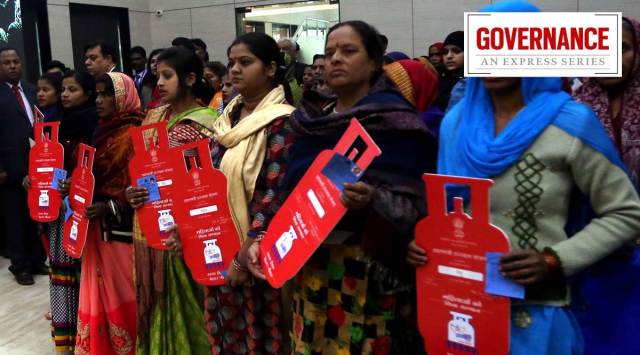‘Ujjwala Effect’: Study estimates over 1.5 lakh lives saved in a year, 13% reduction in air pollution deaths
The researchers maintain that the benefits of Ujjwala measured by them were conservative estimates and the actual benefits could be even higher.
 PMUY helped avoid 1.8 mn tonnes of PM2.5 emissions. File
PMUY helped avoid 1.8 mn tonnes of PM2.5 emissions. FileGreater penetration and usage of LPG as a cooking fuel is estimated to have prevented at least 1.5 lakh pollution-related premature deaths in the year 2019 alone, according to the first independent impact assessment of the government’s flagship Ujjwala programme.
The Pradhan Mantri Ujjwala Yojana (PMUY) also helped in avoiding at least 1.8 million tonnes of PM2.5 emissions that year, this assessment has found.
🗞️ Subscribe Now: Get Express Premium to access the best Election reporting and analysis 🗞️
The study, by Ajay Nagpure, Ritesh Patidar and Vandna Tyagi, who work for the World Resources Institute (WRI) India, is ongoing and still to be peer reviewed. Nagpure, a PhD from IIT Roorkee, has been involved in air pollution-related research for 18 years and was with the Centre for Science, Technology and Environmental Policies at the Hubert Humphrey School of Public Affairs at the University of Minnesota, before moving to India in 2019.
Tyagi, an environmental engineer, was formerly a research fellow at IIT Roorkee, and Patidar, a 2017 graduate from the same institute, has been researching sustainable clean cooking energy solutions, air pollution and related policies.
The researchers maintain that the benefits of Ujjwala measured by them were conservative estimates and the actual benefits could be even higher.
“The avoidance of premature deaths, for example, has been estimated only for indoor air pollution. But cooking fuel also contributes to outdoor air pollution. Earlier studies have indicated that biomass burning in household cooking could be contributing 30-40 per cent of outdoor air pollution. We have not estimated the health or emission benefits of reduction in outdoor air pollution,” Nagpure told The Indian Express.
“Also, the benefits have been estimated for the year 2019 only. Similar benefits would have accrued in subsequent years as well, though we do not have full data as of now. The cumulative benefit of this one single intervention is huge. I would say Ujjwala Yojana would be one of the most effective government interventions to improve air quality and reduce health risks from air pollution,” he said.
For estimating the avoided deaths, Nagpure and his team adopted the methodology used by the Global Burden of Disease (GBD) study, published in The Lancet in October 2020. The GBD study, coordinated by the Institute of Health Metrics and Evaluation at the University of Washington, named air pollution as the fourth biggest killer worldwide (amongst 286 different causes of death), responsible for about 6.67 million deaths in 2019.
That study had found that about 6.1 lakh deaths in India in 2019 could be attributed to household air pollution. It had considered only those households that did not have access to LPG.
In its own research, Nagpure’s team included the impact of pollution even from those households that had an LPG connection but were also using traditional biomass fuels. Using the same methodology, Nagpure’s team estimated that, if such secondary usage of biomass was also taken into account, indoor air pollution-related deaths in 2019 rose to 10.2 lakh.
In the absence of Ujjwala, however, this death number could be as high as 11.7 lakh, the study found. Ujjwala could, therefore, have reduced indoor air pollution deaths by about 13 per cent in a single year.
Deaths due to air pollution were estimated using “exposure-response functions” which are developed through the study of clinical correlations between extent of exposure to pollutants and observed health impacts.
These functions are extrapolated over large population groups.
This exposure-response function developed by the Global Burden of Diseases project is the most widely accepted, and used, metric to estimate deaths due to air pollution, even though it is often argued that it does not capture the Indian situation very accurately.
Due to very high background exposure in India, the health impacts of air pollution on Indian population groups are likely to be slightly lesser than in cleaner countries. It is argued that Indians could have a higher adaptive capacity because of higher baseline of pollutants. However, in the absence of extensive clinical data on Indian populations, the exposure-response functions of GBD are used by most researchers to estimate the impacts in India as well.
The PMUY was launched in 2016 with the objective of providing LPG connection to households that were using traditional fuels like wood, cow-dung cakes or coal for cooking purposes which release lot of pollutants and are damaging to the health of the people, particularly women engaged in kitchen. The target was to provide 8 crore new LPG connections by March 2020.
According to government figures, this target was achieved in September 2019. Government data shows that by January this year, 9 crore new LPG connections had been rolled out under this scheme, and that 99.8 per cent of the over 28 crore households in India now have access to LPG, up from 61.9 per cent in 2015.
But that does not mean that all the households have shifted to LPG. Nagpure’s study found that only 65 per cent of the households in 2019 were using LPG as the primary cooking fuel. Nagpure says in the absence of the push provided by Ujjwala Yojana, this number would have been around 47 per cent.
“The benefits are immense even at 65 per cent usage. These will increase further as more and more households start using LPG as their primary fuel,” Nagpure said.
The findings of Nagpure’s research are consistent with the results of a recent survey carried out by researchers from IIT Kanpur that had reported big health benefits in households that had adopted LPG.
That survey, commissioned by the Health Ministry and carried out in six states, had shown a vast improvement not just in prevalence of respiratory diseases but also in general health conditions in villages with high coverage of Ujjwala connections.
The survey had found 50 per cent improvement in general health conditions in villages of Rajasthan, Uttar Pradesh and Bihar with high coverage of Ujjwala connections.
Sachchida Nand Tripathi, a professor in Department of Civil Engineering at IIT Kanpur, one of the foremost researchers on air pollution in India who was the principal investigator for this project, said he was not surprised by the findings of Nagpure’s research.
“Estimation of death is carried out by internationally standardised methodologies that are used by Global Burden of Diseases project and others. To the extent that these methodologies have some limitations regarding their application in India, there can be some uncertainties in the estimation of avoidance of deaths as well. But that is a matter of detail. There is absolutely no doubt that the Ujjwala programme has a very profound impact on saving lives, and contributing to improvement of health, especially women’s health. And then there are emission-avoidance benefits as well,” Tripathi said.
- 01
- 02
- 03
- 04
- 05































